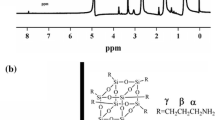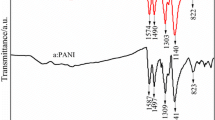Abstract
With the aid of the amphiphilicity and self-assembly ability of surfactant cetyltrimethylammonium bromide (CTAB), we demonstrate an effective method to increase the interlayer spacing of Ti3C2Tx nanosheets, which is beneficial to improve the performance of composites. Electrochemical tests show that Ti3C2Tx/polyaniline, treated by the co-intercalation of CTAB, exhibits higher redox activity and reversibility. A specific capacitance of 336 F·g−1 for as-prepared Ti3C2Tx/polyaniline composite is achieved at a current density of 0.5 A·g−1, 1.43 times greater than that of common Ti3C2Tx/polyaniline composite (236 F·g−1). Most importantly, a specific capacitance of 135 F·g−1 is retained when the current density increases to 16 A·g−1, much higher than 57 F·g−1 for the common composite. The superior charging/discharging capability is attributed to highly active and reversible polyaniline on Ti3C2Tx as well as the enlarged interlayer spacing, which will provide enough channel for the quick diffusion and migration of electrolyte ions.






Similar content being viewed by others
References
Liang B, Qin Z, Li T, Dou Z, Zeng F, Cai Y, Zhu M, Zhou Z (2015) Poly(aniline-co-pyrrole) on the surface of reduced graphene oxide as high-performance electrode materials for supercapacitors. Electrochim Acta 177:335–342
Augustyn V, Simon P, Dunn B (2014) Pseudocapacitive oxide materials for high-rate electrochemical energy storage. Energy Environ Sci 7:1597–1614
Larcher D, Tarascon JM (2015) Towards greener and more sustainable batteries for electrical energy storage. Nat Chem 7:19–29
Fu M, Zhu Z, Chen W, Yu H, Liu Q (2020) Microwave-assisted synthesis of MoS2/graphene composites for supercapacitors. J Mater Sci 55:16385–16393
Fu M, Zhu Z, Zhuang Q, Zhang Z, Chen W, Liu Q (2020) In situ growth of manganese ferrite nanorods on graphene for supercapacitors. Ceram Int 46:28200–28205
Naguib M, Kurtoglu M, Presser V, Lu J, Niu J, Heon M, Hultman L, Gogotsi Y, Barsoum MW (2011) Two-dimensional nanocrystals produced by exfoliation of Ti3AlC2. Adv Mater 23:4248–4253
Mashtalir O, Naguib M, Mochalin VN, Dall’agnese Y, Heon M, Barsoum MW, Gogotsi Y (2013) Intercalation and delamination of layered carbides and carbonitrides. Nat Commun 4:1716
Alhabeb M, Maleski K, Anasori B, Lelyukh P, Clark L, Sin S, Gogotsi Y (2017) Guidelines for synthesis and processing of two-dimensional titanium carbide (Ti3C2Tx MXene). Chem Mater 29:7633–7644
Liu Y, Zhang X, Dong S, Ye Z, Wei Y (2017) Synthesis and tribological property of Ti3C2TX nanosheets. J Mater Sci 52:2200–2209
Chen H, Yu L, Lin Z, Zhu Q, Zhang P, Qiao N, Xu B (2020) Carbon nanotubes enhance flexible MXene films for high-rate supercapacitors. J Mater Sci 55:1148–1156
Hu M, Li Z, Hu T, Zhu S, Zhang C, Wang X (2016) High-capacitance mechanism for Ti3C2TX MXene by in situ electrochemical raman spectroscopy investigation. ACS Nano 10:11344–11350
Xu SK, Wei GD, Li JZ, Ji Y, Klyui N, Izotov V, Han W (2017) Binder-free Ti3C2Tx MXene electrode film for supercapacitor produced by electrophoretic deposition method. Chem Eng J 317:1026–1036
Shi L, Lin SY, Li L, Wu WY, Wu LL, Gao H, Zhang XT (2018) Ti3C2Tx-foam as free-standing electrode for supercapacitor with improved electrochemical performance. Ceram Int 44:13901–13907
Fu M, Chen W, Ding J, Zhu X, Liu Q (2019) Biomass waste derived multi-hierarchical porous carbon combined with CoFe2O4 as advanced electrode materials for supercapacitors. J Alloys Compd 782:952–960
Fu M, Zhu Z, Zhang Z, Zhuang Q, Chen W, Liu Q (2020) Microwave deposition synthesis of Ni(OH)2/sorghum stalk biomass carbon electrode materials for supercapacitors. J Alloys Compd 846:156376
Fu M, Zhu Z, Zhou Y, Xu W, Chen W, Liu Q, Zhu X (2020) Multifunctional pompon flower-like nickel ferrites as novel pseudocapacitive electrode materials and advanced absorbing materials. Ceram Int 46:850–856
Rakhi RB, Ahmed B, Anjum D, Alshareef HN (2016) Direct chemical synthesis of MnO2 nanowhiskers on transition metal carbide surfaces for supercapacitor applications. ACS Appl Mater Interfaces 8:18806–18814
Zhu J, Lu X, Wang L (2016) Synthesis of a MoO3/Ti3C2Tx composite with enhanced capacitive performance for supercapacitors. RSC Adv 6:98506–98513
Zou R, Quan HY, Pan MH, Zhou S, Chen DZ, Luo XB (2018) Self-assembled MXene(Ti3C2Tx)/alpha-Fe2O3 nanocomposite as negative electrode material for supercapacitors. Electrochim Acta 292:31–38
Xia QX, Shinde NM, Yun JM, Zhang T, Mane RS, Mathur S, Kim KH (2018) Bismuth oxychloride/MXene symmetric supercapacitor with high volumetric energy density. Electrochim Acta 271:351–360
Boota M, Gogotsi Y (2019) MXene-conducting polymer asymmetric pseudocapacitors. Adv Energy Mater 9:1802917
Vahidmohammadi A, Moncada J, Chen H, Kayali E, Orangi J, Carrero CA, Beidaghi M (2018) Thick and freestanding MXene/PANI pseudocapacitive electrodes with ultrahigh specific capacitance. J Mater Chem C 6:22123–22133
Le TA, Tran NQ, Hong Y, Lee H (2019) Intertwined titanium carbide MXene within a 3D tangled polypyrrole nanowires matrix for enhanced supercapacitor performances. Chem-Eur J 25:1037–1043
Wu W, Wei D, Zhu J, Niu D, Wang F, Wang L, Yang L, Yang P, Wang C (2019) Enhanced electrochemical performances of organ-like Ti3C2 MXenes/polypyrrole composites as supercapacitors electrode materials. Ceram Int 45:7328–7337
Li Z, Wang L, Sun D, Zhang Y, Liu B, Hu Q, Zhou A (2015) Synthesis and thermal stability of two-dimensional carbide MXene Ti3C2. Mater Sci Eng B 191:33–40
Lukatskaya MR, Mashtalir O, Ren CE, Dall’agnese Y, Rozier P, Taberna PL, Naguib M, Simon P, Barsoum MW, Gogotsi Y (2013) Cation intercalation and high volumetric capacitance of two-dimensional titanium carbide. Science 341:1502–1505
Wang L, Wang A (2008) Adsorption properties of Congo Red from aqueous solution onto surfactant-modified montmorillonite. J Hazard Mater 160:173–180
Luo JM, Zhang WK, Yuan HD, Jin CB, Zhang LY, Huang H, Liang C, Xia Y, Zhang J, Gan YP, Tao XY (2017) Pillared structure design of MXene with ultralarge interlayer spacing for high-performance lithium-ion capacitors. ACS Nano 11:2459–2469
Meng Q, Cai K, Chen Y, Chen L (2017) Research progress on conducting polymer based supercapacitor electrode materials. Nano Energy 36:268–285
Simotwo SK, Delre C, Kalra V (2016) Supercapacitor electrodes based on high-purity electrospun polyaniline and polyaniline-carbon nanotube nanofibers. ACS Appl Mater Interfaces 8:21261–21269
Feng L, Wang K, Zhang X, Sun X, Li C, Ge X, Ma Y (2018) Flexible solid-state supercapacitors with enhanced performance from hierarchically graphene nanocomposite electrodes and ionic liquid incorporated gel polymer electrolyte. Adv Funct Mater 28:1704463
Jabeen N, Xia Q, Yang M, Xia H (2016) Unique core-shell nanorod arrays with polyaniline deposited into mesoporous NiCo2O4 support for high-performance supercapacitor electrodes. ACS Appl Mater Interfaces 8:6093–6100
Ren YY, Zhu JF, Wang L, Liu H, Liu Y, Wu WL, Wang F (2018) Synthesis of polyaniline nanoparticles deposited on two-dimensional titanium carbide for high-performance supercapacitors. Mater Lett 214:84–87
Li Y, Kamdem P, Jin X-J (2021) Hierarchical architecture of MXene/PANI hybrid electrode for advanced asymmetric supercapacitors. J Alloys Compd 850:156608
Dai B, Zhao B, Xie X, Su T, Fan B, Zhang R, Yang R (2018) Novel two-dimensional Ti3C2Tx MXenes/nano-carbon sphere hybrids for high-performance microwave absorption. J Mater Chem C 6:5690–5697
Wang S, Ma Z, Lu Q-F, Yang H (2019) Two-dimensional Ti3C2TX/polyaniline nanocomposite from the decoration of small-sized graphene nanosheets: promoted pseudocapacitive electrode performance for supercapacitors. ChemElectroChem 6:2748–2754
Wang X, Zhou Y (2002) Solid–liquid reaction synthesis of layered machinable Ti3AlC2 ceramic. J Mater Chem 12:455–460
Wang Q, Li J, Wang D, Niu J, Du P, Liu J, Liu P (2020) Enhanced electrochemical performance of polyaniline-based electrode for supercapacitors in mixed aqueous electrolyte. Electrochim Acta 349:136348
Guan S, Dong Y, Jiang G, Huang R, Yuan S (2019) Preparation and electrochemical performance of two-dimensional Ti3C2Tx with surfactant as ancillary intercalation agent. J Funct Mater 2019(50):9142–9146
Funding
This work was supported by grants from the National Natural Science Foundation of China (No. 21207033), the Hubei Province Technology Innovation Project (2018AAA056), the Natural Science Foundation of Hubei Province of China (No.2016CFB505), and the Open Fund of Hubei Provincial Key Laboratory of Green Materials for Light Industry (No. 201907B11).
Author information
Authors and Affiliations
Corresponding author
Additional information
Publisher’s note
Springer Nature remains neutral with regard to jurisdictional claims in published maps and institutional affiliations.
Rights and permissions
About this article
Cite this article
Dong, Y., Guan, S., Zhou, X. et al. Co-intercalation of CTAB favors the preparation of Ti3C2Tx/PANI composite with improved electrochemical performance. Ionics 27, 2501–2508 (2021). https://doi.org/10.1007/s11581-021-04025-w
Received:
Revised:
Accepted:
Published:
Issue Date:
DOI: https://doi.org/10.1007/s11581-021-04025-w




